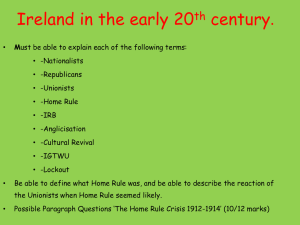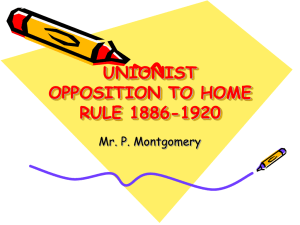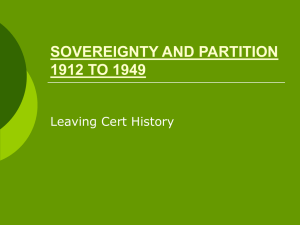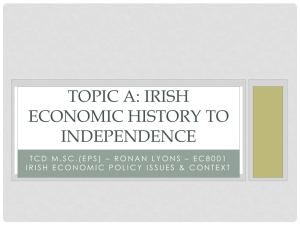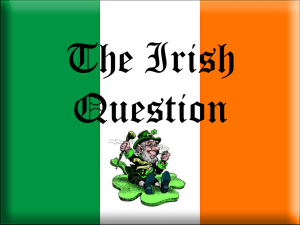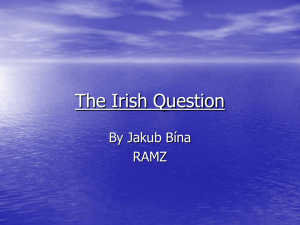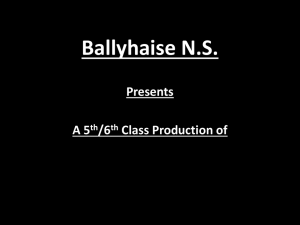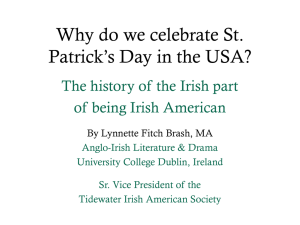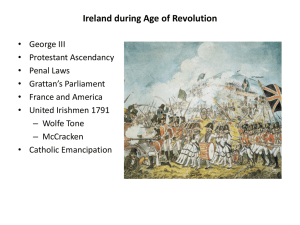File - Miss O`Connor`s Class
advertisement
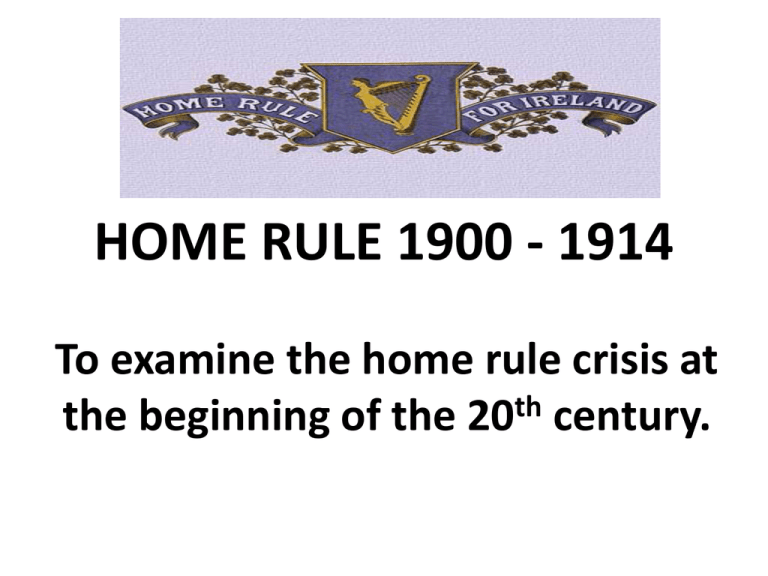
HOME RULE 1900 - 1914 To examine the home rule crisis at the beginning of the 20th century. 1900 – 1909 • REUNION – By 1900 many Irish Nationalists were tired of the fighting between the Parnellites and AntiParnellites and began to drift into the United Irish League. This united the both groups with John Redmond (Parnellite) becoming leader and John Dillon (antiParnellite) his deputy. • LIBERALS RETURN – In 1906 the Liberals returned under HH Asquith. They had a massive majority and did not need Irish support, so Home Rule was not a priority. • REFORMS – Birrell’s Land Act (1909) provided money for land purchace, old age pensions were introduced, National University of Ireland was established. CONFLICT WITH THE LORDS • 1909 BUDGET – A rejected budget in 1909 resulted in Asquith calling a general election. • BALANCE OF POWER – Dillon and the Home Rule Party held the balance of power between the Liberals and Conservatives after the election and used this position to win a promise of Home Rule from Asquith and the Liberals. • 3rd HOME RULE BILL – After the Lords’ veto had been destroyed, the Third Home Rule Bill was introduced into the Commons on 11th April 1912. This would give an Irish parliament jurisdiction over all internal affairs except taxation and police and Ireland would continue to send 40 MPs to Westminster. With the Lords two year delaying power, it was expected to become law in 1914. 1st July 1914: John Dillon (1851-1927) and John Edward Redmond (1856 - 1918) leaving Buckingham Palace in London after the Home Rule for Ireland Conference Can you identify any possible problems the Third Home Rule Bill might face? 1. English public 2. Conservatives 3. Irish Nationalists 4. House of Lords 5. International Issues KEY FIGURES John Redmond – Leader of the Home Rule Party John Dillon – Deputy of the Home Rule Party John Redmond – Key points • • • • • • • • • • born in 1856 mixed religious background Home Rule MP Plan of Campaign Parnellite Recess Committee Home Rule Party reunited United Irish League social reforms 3rd Home Rule Bill in 1912 John Redmond – Biography • John Redmond was born in 1856 into a wealth merchant family in Co. Wexford. He was of mixed religious background and attended Jesuit-run Clongowes Wood College and Protestant Trinity College. Redmond was impressed by Parnell and his own father, a Home Rule MP and became a MP for New Ross in 1881 after his father’s death. He was a good public speaker and jailed for five weeks in 1888 for his part in the Plan of Campaign. Redmond continued to support Parnell during the O’Shea divorce case and was elected leader of the Parnellite faction in 1891. Unlike Parnell, Redmond worked with all political parties to bring reform to Ireland. John Redmond – Biography • He took part in the Recess Committee, which established the Department of Agriculture and Technical Instruction in Ireland in 1899. He also attempted to show unionists that they had nothing to fear from Home Rule in Ireland. The Home Rule Party reunited in 1900 with Redmond as leader and Dillon (Anti-Parnellite) as his deputy. There was increased interest in Home Rule and land rights with the United Irish League. After years of being appeased with social reforms – Evicted Tenants Act, Old Age Pension, Universities Act and Land Act – success looked possible with the 3rd Home Rule Bill in 1912. He defeated Michael Davitt as MP for Waterford and held that seat until his death in 1918. OBJECTIONS TO HOME RULE • The two main objectors to home rule were Unionists and the British. What does this cartoon show? What was Unionism? Unionists were opposed to any change to the 1801 Act of Union between Britain and Ireland – Ireland as part of the United Kingdom, governed by one parliament. Irish Unionism HISTORICAL RELIGIOUS Descended from English plantation settlers. Mainly Church of Ireland, Presbyterian or Methodist. UNIONISM • ULSTER UNIONISTS – They came from different backgrounds and churches in North East Ulster but were united under the Orange Order. They claimed to be more truly British than Catholics or Nationalists. • SOUTHERN UNIONISTS – They were scattered in pockets throughout the country and were associated with gentry, professions and Trinity College. They were more tolerant of Catholics than Ulster Unionists but were willing to use their power to preserve their position of privilege. Why did Unionists fear Home Rule? • Loss of political control – Unionists would become the minority, hold less positions and become politically insignificant. • Economic fears – They believed that a HR parliament would want to protect small industry and put tariffs on imports, which would harm large industries in Northern Ireland like Harland and Wolff. • Religion – Nearly 80% of Ireland was Catholic and Unionists feared that they would be controlled by the Church. Home Rule = Rome Rule. Why did Unionists fear Home Rule? • Racial views – Some Unionists believed that the Irish weren’t fit to govern themselves. The stereotype of an Irish Nationalist was a stupid, violent, ape-like figure. – Was this view limited to the Irish? See p.84 • The British Empire – The Empire was a source of pride, prosperity and security – jingoism. They believed that the Empire would weaken and Ireland would become inward looking. • Fear of Irish Republicanism – They were fearful of the violent elements of the Nationalist movement, such as the IRB, and that without Britain, they would have no protection. BELFAST UNDER HOME RULE Examine the cartoon, which shows an imagined Belfast under Home Rule, and answer the following questions: 1. Is this cartoonist for or against Home Rule? How do you know this? 2. What does the cartoonist suggest will be the future for Belfast under Home Rule? 3. Give some details about the leaders identified in the statues. See page 103 for picture THE HOME RULE CRISIS CARSON & CRAIG Opposition to Home Rule was directed by Dublin lawyer, Sir Edward Carson and Belfast businessman, James Craig. Carson was a brilliant speaker and organiser and Craig financed the opposition. They had support of the Conservatives and 400,000 men who signed the Solemn League and Covenant in 1912, which promised to fight Home Rule ‘using all means’. This became militant as the Ulster Volunteer Force (UVF) distributed (gave out) ammunition. With support from the British army, the UVF staged a rebellion in the North without firing a single shot. THE IRISH VOLUNTEERS • In An Claidheams Soluis, Eoin MacNeill claimed that Ulster Unionists were practicing their own Home Rule. MacNeill set up and was elected Chief of Staff of the Irish National Volunteers. By 1912 it had 75, 000 members and Redmond nominated 25 members to its Provisional Committee. Similar to the UVF, the Volunteer ran guns and ammunition into Howth in 1914. They did not have the support of the British army or police and the troops shot into the jeering crowd, killing three people. END OF HOME RULE CRISIS • King George V called the Home Rulers and the Unionists to a Conference in Buckingham Palace to try and prevent civil war. • This became irrelevant when Britain entered into World War I in 1914. The Third Home Rule Bill became law on 18th September 1914 but its operation was postponed until after the war. By this time it would become a dead issue. • During the war Redmond pledged to defend Ireland and encouraged Volunteer to join up to Irish regiments. Not all Volunteers agreed with him and 10, 000 men remained with MacNeill and pledged to keep the organisation together until Home Rule was passed. What are the different messages in these two war posters? John Redmond Recruitment Poster Sinn Fein Protest Poster
